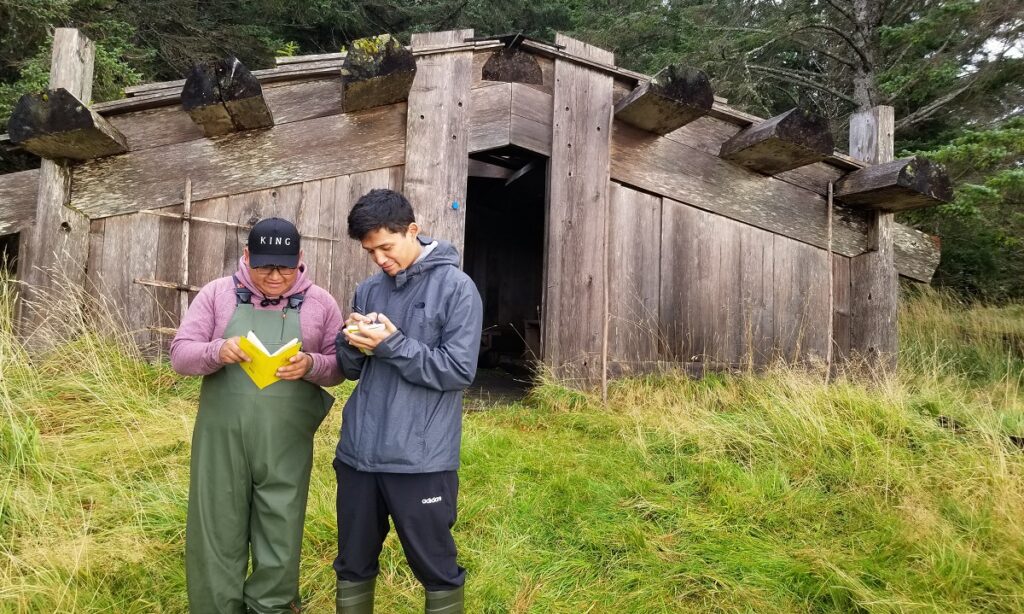Text by Emilee Gilpin and photos by Jackie Peat.
The fourth cohort of the Stewardship Technicians Training Program (STTP) for Indigenous Guardians and other stewardship staff working for their Nations gathered in Haida Gwaii for their first in-class session since before the COVID pandemic began.
STTP serves First Nations on the North and Central Coast and Haida Gwaii, including Wuikinuxv, Heiltsuk, Kitasoo/Xai’xais, Nuxalk, Gitga’at, Gitxaala, Metlakatla, Old Masset, Skidegate and Council of the Haida Nation. The university-accredited program, a partnership between Coastal First Nations and Vancouver Island University, is custom designed to give students applied skills and knowledge required to work for their Nations. Potential employment opportunities upon completion of STTP include Coastal Guardian Watchmen, fisheries technicians, heritage surveyors and environmental monitors.

Jackie Peat, who has been working as the STTP training coordinator with the Coastal Stewardship Network since fall 2019, joined the students in September in Haida Gwaii for two weeks of in-field, in-person classes on marine ecology and compliance monitoring. The 13 students from six different Nations have been meeting for online classes since January, and gathering together was a welcome relief.
“The program is geared towards lining people up to work for their Nations in stewardship, fisheries, as Guardians, and as technicians,” Jackie says. “Many people are sponsored through their stewardship offices, and many work for their Nations already.”
Jackie says STTP is focused on upholding Indigenous laws for how to care for the lands and waters, and from there, it builds on “personal growth and confidence to undertake that work and do it in a good way.”
“Throughout STTP, we have Indigenous counsellors available to offer support, Elders are present to share stories and wisdom, and students are immersed in cultural activities in the community and on the land,” Jackie explains. “We strive to uplift the students and support them to stay culturally grounded. From there, we layer on technical skills, specific scientific monitoring and data collection protocols.”
“The program captures the essence of what it means to be a Guardian,” adds Jackie. “It’s about connecting to the land, connecting to culture, and building up technical skills to act as stewards of the land and water.”

‘We know the land inside and out’
Carlos Edgar, who is Nuxalk from Bella Coola, is one of the students who participated in the fourth STTP cohort. Carlos has been working as a Nuxalk Guardian this past year, a job he loves. He says the work varies day-to-day, but involves monitoring logging activity, carrying out compliance checks for fishing boats, data collection for crab, rockfish and other species, as well as bear research, marine monitoring and patrolling the parks.
“It’s necessary for Indigenous Peoples to do this work,” he says. “We harvest every year, we know if it’s a good harvest, a bad harvest, if there are things struggling, we have hands-on, in-depth knowledge.” Guardians know the landscape of their territories, he says, “how everything moves and walks in the area inside and out.”
As for the STTP courses, Carlos says that he was thrilled to be in Haida Gwaii for two weeks and to get out on the beaches. “Everyone has a different story from their own Nation,” he says, “with different levels of experience and different ages… it’s so exciting.”

‘Climate change is real’
Nicole Robinson agrees. Another student from this year’s STTP cohort, Nicole is Gitga’at from Hartley Bay. Although she became a Gitga’at Guardian in January 2021, she spent the last six years working with the program, based at a cabin in the outer islands of her territory. Nicole says she recorded “everything that moves but bugs,” focusing mainly on cetaceans and marine mammals, especially humpback whales, fin whales and orcas.
“We’re the eyes and ears of the ocean,” Nicole says. “We know the territory well. It’s fine to have people come in, but we know what’s going on, the effects of climate change, the changes in our lands, the dangers. We live and breathe it.”
Indigenous Peoples carry knowledge passed on from their ancestors and Elders, she says, and while a lot of knowledge can be taught, “you can’t fully learn anything unless you live it.”
“Climate change is real,” says Nicole, who spent summer after summer in the outer islands and saw a lot more storms coming in. She also witnessed and monitored different weather patterns, warmer temperatures, changes to or loss of species, including kelp, birds, whales, berries and cedars.
Nicole discussed these changes with other STTP students, as they share knowledge about the changes they’re monitoring in their respective territories, and the ways they’re dealing with them. “We get to learn about the different territories and their traditional knowledge, how things have been passed on, similar struggles,” she says. “It’s a great group of people, and you can feel the connection between our communities.”



